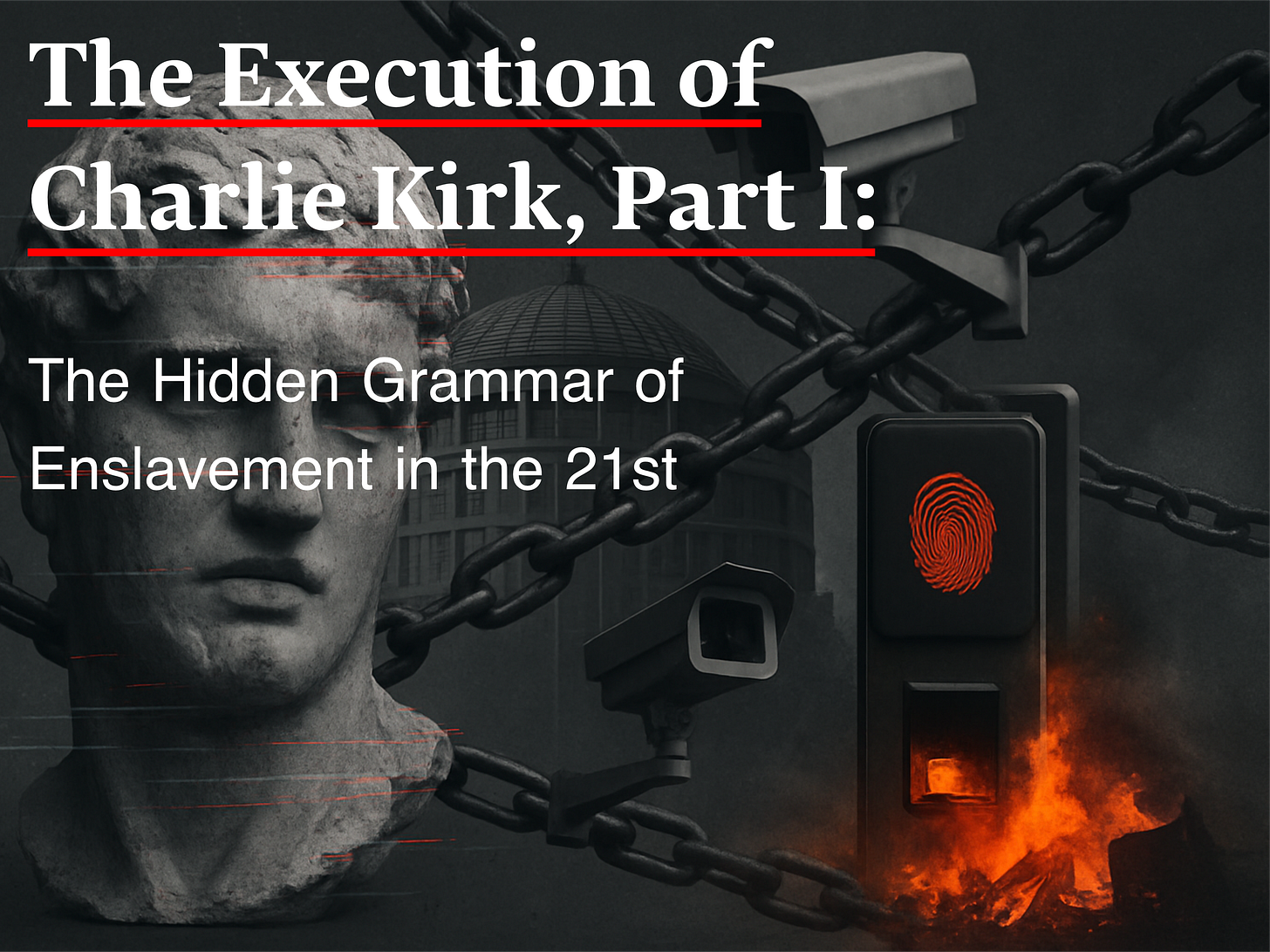The Execution of Charlie Kirk, Part I: Crisis, Control, and the Structural Logic of Enslavement
The Hidden Grammar of Enslavement in the 21st Century
Introduction
This is the first part of a two-part series. Here I outline the theoretical framework: how crises function not as accidents but as instruments of governance, and how the dynamic of problem – reaction – solution has become the hidden architecture of modern power.
In Part II, I will turn to contemporary signals — real-world cases across economics, technology, politics, media, and biopolitics — that show how this logic is already at work.
The reported execution of a public figure such as Charlie Kirk should not be read merely as an isolated act of political violence. Rather, it must be understood as part of a broader pattern in which shocks and spectacles of disorder are mobilized as instruments of power. As political theorists have shown, moments of rupture often function not as interruptions but as accelerants: they fast-forward agendas that would otherwise meet resistance.
Problem – Reaction – Solution
Naomi Klein, in The Shock Doctrine (2007), described how crises are used to push through reforms that would be unthinkable in ordinary times. Her thesis echoes Giorgio Agamben’s State of Exception (2005), which shows how emergency powers — initially temporary — become normalized as tools of governance.
Seen through this lens, the “execution” operates less as disruption than as trigger. The problem is the spectacle of crisis; the reaction is fear, outrage, polarization; the solution is the consolidation of power. This unfolds through:
expansion of surveillance (Michel Foucault, Discipline and Punish, 1975)
curtailment of dissent (Noam Chomsky & Edward Herman, Manufacturing Consent, 1988)
algorithmic risk scoring (Shoshana Zuboff, The Age of Surveillance Capitalism, 2019)
permanent emergency powers (Agamben, 2005)
The crisis is not the cause but the catalyst.
Structural Domains of Control
To grasp how this works, we need to disaggregate the machinery of governance into five interlocking domains:
Economic – debt and austerity trap entire populations; programmable currencies shift financial sovereignty from people to institutions.
Technological – mass surveillance and algorithmic gatekeeping silently shape behavior and visibility.
Political/Legal – emergency powers, once enacted, rarely disappear; supranational treaties move authority beyond the nation-state.
Narrative – media concentration narrows the horizon of discourse; ideology reproduces consent through education, advertising, and entertainment.
Biopolitical – health mandates and climate regimes govern life itself, linking bodies and resources to systems of compliance.
This is what some critics call “soft enslavement”: not chains, but the narrowing of options until obedience feels like necessity.
The Elite, the Awake, and the Asleep
Vilfredo Pareto argued in The Rise and Fall of Elites (1916) that history is driven by the circulation of ruling minorities. Antonio Gramsci, writing in prison in the 1930s, saw resistance emerging through counter-hegemony — subaltern groups building their own narratives.
We can think of the present landscape in three positions:
The elite: those with concentrated control of economic, political, and technological infrastructure.
The awake: those who perceive patterns of control and seek to resist them.
The asleep: the majority, whose consent is manufactured through ideology (Louis Althusser, Ideology and Ideological State Apparatuses, 1971).
It is this triangular tension — between hegemony, counter-hegemony, and mass compliance — that defines our present.
From Uprisings to Sieges
Across Europe, we see protests escalating into confrontations with state institutions. Guy Standing, in The Precariat (2011), describes how insecurity creates a volatile new class. When housing crises, unemployment, and rising costs converge, legitimacy fractures.
Hannah Arendt, in On Violence (1970), observed that violence emerges where power loses legitimacy. The storming of parliaments — whether in Berlin, Paris, or London — is more than protest. It is a symbolic assault on institutions themselves.
The Paradox of Chaos
For elites, chaos is paradoxical. It is necessary to justify deeper control, but dangerous if it escapes their grip. The solution is to manufacture or amplify shocks that channel fear without collapsing the system.
Thus the cycle repeats: crisis, consolidation, normalization. The execution of Charlie Kirk can be read not as an aberration but as another lever in this cycle — a tool for recalibrating legitimacy through fear.
Conclusion
Accidental crisis, seen through this lens, is anything but accidental. The “war” between elites, the awake, and the asleep is not metaphorical, but structural. Each escalation — from uprising to siege to execution — redistributes power, perception, and legitimacy.
The agenda is not liberation but control through chaos, order through fear.
This essay has traced the theoretical grammar of that dynamic. In Part II, I will show how this grammar is already written into today’s institutions, technologies, and policies.
📌 Note on Sources
This essay draws on the work of Naomi Klein (The Shock Doctrine), Giorgio Agamben (State of Exception), Michel Foucault (Discipline and Punish), Shoshana Zuboff (The Age of Surveillance Capitalism), Antonio Gramsci (Prison Notebooks), Hannah Arendt (On Violence), Vilfredo Pareto (The Rise and Fall of Elites), Louis Althusser (Ideology and Ideological State Apparatuses), Guy Standing (The Precariat), and Noam Chomsky & Edward Herman (Manufacturing Consent).




A Eurotrash buffet of abstract nouns signifying very little.